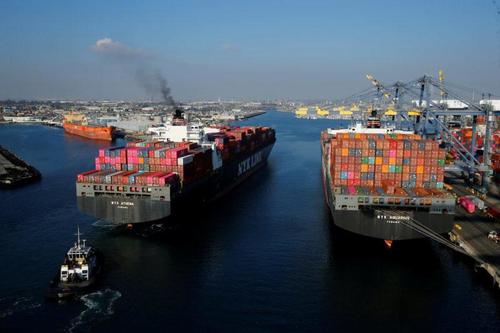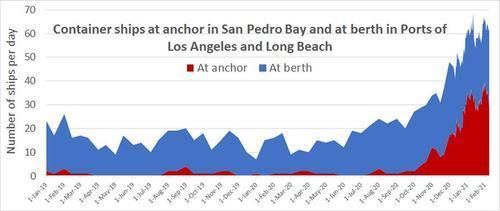Port Of Los Angeles Logs Busiest First Quarter On Record Following “Consumer Spending Surge”
Throughout the virus pandemic, all cargo terminals at the Port of Los Angeles, one of the most important seaports in the US, have remained opened and are experiencing incoming record cargos as trillions of dollars in stimulus results in one-sided trade with Asia.
The US logistical economy continues to overheat as the federal government has been on a multi-trillion dollar helicopter money drop since the beginning of the virus pandemic. The latest is $1.9 trillion, with hundreds of billions of dollars issued in the form of checks to Americans.
“Helicopter money” was first defined by economist Milton Friedman in 1969 as a thought experiment where a helicopter drops cash over a town. It was thought to be a one-off event, but today’s federal government has continued to drop free money in the form of stimulus checks to supercharge consumers.
The stimulative effect of handing out free money to households is surging consumption. Tens of millions of Americans bought goods, many of which are produced overseas and have to flow through West Coast ports, such as the Port of Los Angeles, in containerized form.
S&P Global Platts reports the Port of Los Angeles had the busiest March and first quarter on record, handing upwards of 2.6 million 20-foot equivalent units (TEU) of imports in the three months ending March 2021.
In March alone, the port moved 957,599 TEUs, doubling levels moved during the same month of last year, right before the virus pandemic.
“The consumer spending surge continues unabated, with more of us vaccinated, businesses opening, economic outlook looks strong,” said Gene Seroka, executive director of the port. “Consumers are spending as fast as importers can stock their shelves.”
Stimulus checks sparked one-sided trade with Asia, making China to US West Coast shipping lane one of the world’s busiest over the last year. For instance, volumes at the port (as of March) recorded the eighth consecutive month of year-on-year increases. Over this period, the port averaged 900,000 TEU per month, another record.
“The port handled 490,115 loaded TEU imports, up 122.5% on the year. Firm consumer demand for furniture, home goods and appliances, athletic equipment and automotive parts helped drive the record number of imports,” Seroka said.
Exports from the port were a measly 122,899 TEU, up just 1.5% compared with March of 2020.
The latest round of stimulus is expected to continue strong inbound volumes for the port through quarter two. April estimates show volumes of around 880,000 TEU, up 20% over the same period last year.
Other estimates show, for the first time, the port could exceed 10 million TEU for its fiscal year ending June 30.
The influx of containerships means the port is at capacity as a massive congestion crisis of moored vessels is waiting to unload their cargo.
It’s not just a ship pileup that Californian ports are dealing with; one-sided trade with Asia (mainly China), sparked by fiscal stimulus, has resulted in the greatest demand-pull for consumer products ever. Over the months, we’ve documented the massive container shortage in Asia as containers pile up at US West Coast ports.
Empty exports in March topped nearly 345,000 TEU, representing a 219% increase on the year.
“Based on our assessment, it’s quicker [for ocean carriers] to get the empties moved out on the ships and to the loading port in Asia than it would be to give containers to exporters here,” Seroka said.
Due to the trade imbalance, which by the way, sent the US trade deficit to a record high in February, containerized shipping rates for the West Coast North America to North Asia was about $630/FEU (forty-foot equivalent unit) on April 14. For North Asia to West Coast North America, the rate was much higher, at around $4,000/FEU.
… and come to think about it, stimulus checks are just supporting foreign manufacturing economies as Americans buy electronics, furniture, home goods, and appliances, mainly produced overseas.
The high containerized flows into the West Coast ports are not sustainable unless the federal government ushers in universal basic income, which appears not that far off.
Tyler Durden
Tue, 04/20/2021 – 09:50
via ZeroHedge News https://ift.tt/3ath2S6 Tyler Durden

